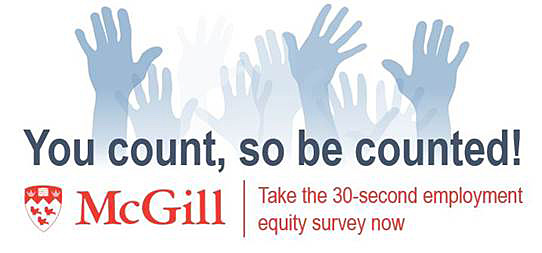
In August 2017, McGill launched a new Employment Equity Survey that is intended to help the University ensure the full participation and career advancement of all groups within the McGill workforce. Though short in length – taking about 30 seconds to complete – the Survey will have a significant impact on the University by helping identify employment barriers for underrepresented groups and ensuring their appropriate representation at McGill.
The McGill Reporter sat down with Angela Campbell, Associate Provost (Equity and Academic Policies), and Tynan Jarrett, Employment Equity Advisor, to look at the Survey in detail and find out why it is so important that all McGill employees complete it.
Why an employment equity survey?
Angela Campbell: All universities should have a tool to collect data about its population, in this case, about its workforce. It’s like a census to see who works here.
McGill has had an employment equity survey since 2007, after the Employment Equity Policy was created. The original survey was quite basic in terms of the data we were collecting, and in fact it didn’t completely fulfill our obligations under the policy.
The survey launched in August 2017 is more refined and gives us a more detailed picture of who makes up our workforce.
Tynan Jarrett: Having a better idea of who we have in our workforce allows us to identify gaps within employment at McGill. We then analyze these gaps to try to understand barriers to employment for underrepresented groups. It is a dynamic process where we use the survey results to develop and implement strategies to address the issue of underrepresentation, and then check to see if the strategies are working by looking updated survey results.
How important is it for people to take the survey?
TJ: The more people respond, the more complete our picture is of McGill’s workforce, and the better we can effectuate positive changes for employees and for McGill overall.
AC: The survey is designed to be as quick – about 30 seconds! – and as painless as possible. But Those 30 seconds can make a real difference.
Can you give us some examples of “gaps in our workforce” and how the University can address them?
AC: Visible minorities are underrepresented across job categories at McGill, but with our former survey that was all the information we had. We didn’t know, for example, how many people identified as Latin American versus South Asian. The Survey will give us a clearer picture of these important details.
In particular, we know that Black and Indigenous professors are underrepresented at McGill and in the academy more broadly. It’s important for us to acknowledge that, try to understand why that is the case, and do work to promote access to the institution and success for colleagues who are here. The same is true for Indigenous professors at McGill.
TJ: People with disabilities are another group that is significantly underrepresented within the McGill workforce, among support and admin staff as well as within the academic complement. Some examples of strategies we can use to reduce this gap include ensuring a streamlined and comprehensive mechanism for job applicants and employees seeking workplace accommodations; education to raise awareness of disability rights and prevent and address direct and indirect discrimination on campus; and measures aimed at enhancing access by dismantling physical barriers to our buildings and properties.
What do you say to those people who read “employment equity” and think “quotas”?
AC: We often hear that employment equity strategies are synonymous with affirmative action, quotas or positive discrimination. It is important for people to understand that this is not at all what the policy at McGill endorses or permits.
Quotas would be reserving a set number of spots for candidates of a particular identity group. Affirmative action would be discriminating positively in favour of people from underrepresented groups. This is not what we do at McGill.
In policy and in practice McGill tries to recruit as widely as possible so that we have a diverse a pool to choose from for every job opportunity that comes up whether it is academic or not.
The goals are to populate the applicant pool in a way that is equitable and proactive. It’s a question of taking initiative rather than just letting people come to you. In recruiting new employees, we have to be proactive, strategic and ambitious.
TJ: Once we have an excellent and diverse pool of applicants, we have to ensure that we are taking steps to address possible bias in the review process. This means, among other things, becoming aware of how bias can impact our assessment of candidates, and taking steps to ensure that we are evaluating candidates based on actual job requirements, not on whether we feel (unconsciously or not) an affinity towards them. This means working intentionally to avoid common pitfalls like giving preference to candidates whose profile is similar to our own, and being open to questioning what we think we know about a field, method of research, or non-traditional career trajectory.
It sounds like a lot of work compared to just posting a job opening and waiting for applicants.
TJ: There is work involved, but ultimately it is work that is worth it – it makes us a better institution, and all of our lives are enriched by it.
There is a common misconception that underrepresentation in our workforce is a result of past discrimination. According to this perspective, workforce representation will increase gradually on its own without deliberate effort.
On the other hand, when you look at McGill workforce data between 2008 and 2015, a time when the institution was implementing minimal strategies around Employment Equity, we see that the needle was flat: the numbers of designated group members in our workforce did not increase. So, there was little-to-no increase among racialized or Indigenous employees, nor among employees with disabilities during this period, despite significant underrepresentation of these groups within the workforce. And the number of women academics increased during this period, but only slightly.
In reality, ensuring we have a diverse and representative workforce takes dedicated work and resources. It takes effort not just from central administration or from Human Resources, but from everyone across the University, regardless of their position, department or unit. We need to read and apply research and be strategic about our hiring and retention practices if we want to succeed.
So, with deliberate action, positive change happens, and we will be a better University for it.
People sometimes politicize issues of employment equity, don’t they?
AC: Sometimes they do, yes. But at McGill, issues of equity and diversity are not about left-wing, right-wing ideologies. It is in line with best practices in all research-intensive universities.
The way in which our Employment Equity Policy has been imagined, crafted and rolled out is based on research. We know that people do better in an environment that is diverse and that brings to gather people with varied experiences, ideas and perspectives.
So how does the employment equity work when hiring new personnel?
AC: Shortlists for academic searches have to be approved by the Provost’s Office. Either Tynan or I look at all shortlists formed by search committees to make sure they include at least one member of an equity-designated group. If that is not the case, the department has to provide a credible justification.
In cases where you have two excellent candidates, both of whom meet the qualifications for the position, the priority should go to the candidate from the least-represented group. For example, if you have a man and a woman applying for a position in a STEMM field and they are both equally capable in the committee’s eyes, then the offer should first go to the female candidate, being that women are underrepresented in that field.
Is there a timeframe for the Survey and what kind of response rate are you looking for?
TJ: The survey is ongoing. We have an obligation to have at least an 80 percent response rate according to provincial employment equity legislation, and we have an internal target to meet that goal by May 2019, which is the next time we will be reporting to Senate on employment equity at McGill.
What has the response rate been thus far?
TJ: We are at a 45 per cent response rate overall but we’ve hit over 50 percent for tenure-track faculty and over 60 percent for employees who are part of MUNACA and MUNASA. We are not there yet, but we are getting there.
Employment equity extends beyond hiring policies, doesn’t it?
AC: Absolutely. It’s one thing to have processes to ensure that there is good representation from diverse groups, but if individuals arrive as employees and the climate is not welcoming, it can be isolating and alienating. That isn’t conducive to supporting a person’s success or to retaining them. Therefore, our goal is to craft an environment that celebrates the excellence that is achieved through diversity.
How does this kind of initiative impact McGill’s student body?
AC: A monolithic workforce would not be helpful to our students. McGill has an extremely diverse student population. Our students should see themselves reflected in the professors who teach them, and in the staff who deliver services within our University.
Learn more about the Employment Equity Survey online. Better yet, take the Survey now.
